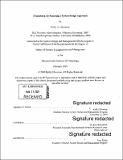| dc.contributor.author | Chiverton, Kelly A. | en_US |
| dc.contributor.other | Massachusetts Institute of Technology. Engineering Systems Division. | en_US |
| dc.contributor.other | System Design and Management Program. | en_US |
| dc.date.accessioned | 2022-08-31T16:29:16Z | |
| dc.date.available | 2022-08-31T16:29:16Z | |
| dc.date.copyright | 2020 | en_US |
| dc.date.issued | 2020 | en_US |
| dc.identifier.uri | https://hdl.handle.net/1721.1/145225 | |
| dc.description | Thesis: S.M. in Engineering and Management, Massachusetts Institute of Technology, Engineering Systems Division, System Design and Management Program, 2020 | en_US |
| dc.description | Cataloged from PDF version of thesis. | en_US |
| dc.description | Includes bibliographical references (pages 93-98). | en_US |
| dc.description.abstract | Recent discussions within the Department of Defense highlight the growing need for US military systems to rapidly respond to new missions, threats, and operational environments that the warfighter can and cannot anticipate. In an effort to respond to the government-wide emphasis of fielding Department of Defense systems smarter and faster, this thesis examines the engineering fundamentals of system design options. The thesis analyzes two umbrella categories of design strategies: static vs. flexible. It also explores subcategories of the two design approaches: optimized, robust, real options, and adapt. Relevant literature is used to define the design strategies, understand the benefits and penalties of each approach, and explore historical examples of each design's use within the Department of Defense. Based on the literature review, the thesis proposes a decision framework for selecting an optimal design approach that characterizes system tradeoffs between dynamic market needs, the rate of technology change, and a system's future operating environment against the value of the proposed design, with the goal of choosing the most cost effective and responsive system design under a given set of objectives and uncertainties. A series of interviews with Air Force Field Grade Officers are used to inform the usefulness and understandability of the decision framework. The interviews also highlight framework limitations. Ultimately, the interview responses solidify a recommendation for the Air Force to implement this framework prior to a system's development. | en_US |
| dc.description.statementofresponsibility | by Kelly A. Chiverton. | en_US |
| dc.format.extent | 107, 1 unnumbered pages | en_US |
| dc.language.iso | eng | en_US |
| dc.publisher | Massachusetts Institute of Technology | en_US |
| dc.rights | MIT theses may be protected by copyright. Please reuse MIT thesis content according to the MIT Libraries Permissions Policy, which is available through the URL provided. | en_US |
| dc.rights.uri | http://dspace.mit.edu/handle/1721.1/7582 | en_US |
| dc.subject | Engineering Systems Division. | en_US |
| dc.subject | System Design and Management Program. | en_US |
| dc.title | Framework for selecting a system design approach | en_US |
| dc.type | Thesis | en_US |
| dc.description.degree | S.M. in Engineering and Management | en_US |
| dc.contributor.department | Massachusetts Institute of Technology. Engineering Systems Division | en_US |
| dc.contributor.department | System Design and Management Program. | en_US |
| dc.identifier.oclc | 1341991407 | en_US |
| dc.description.collection | S.M. in Engineering and Management Massachusetts Institute of Technology, Engineering Systems Division, System Design and Management Program | en_US |
| dspace.imported | 2022-08-31T16:29:16Z | en_US |
| mit.thesis.degree | Master | en_US |
| mit.thesis.department | Sloan | en_US |
